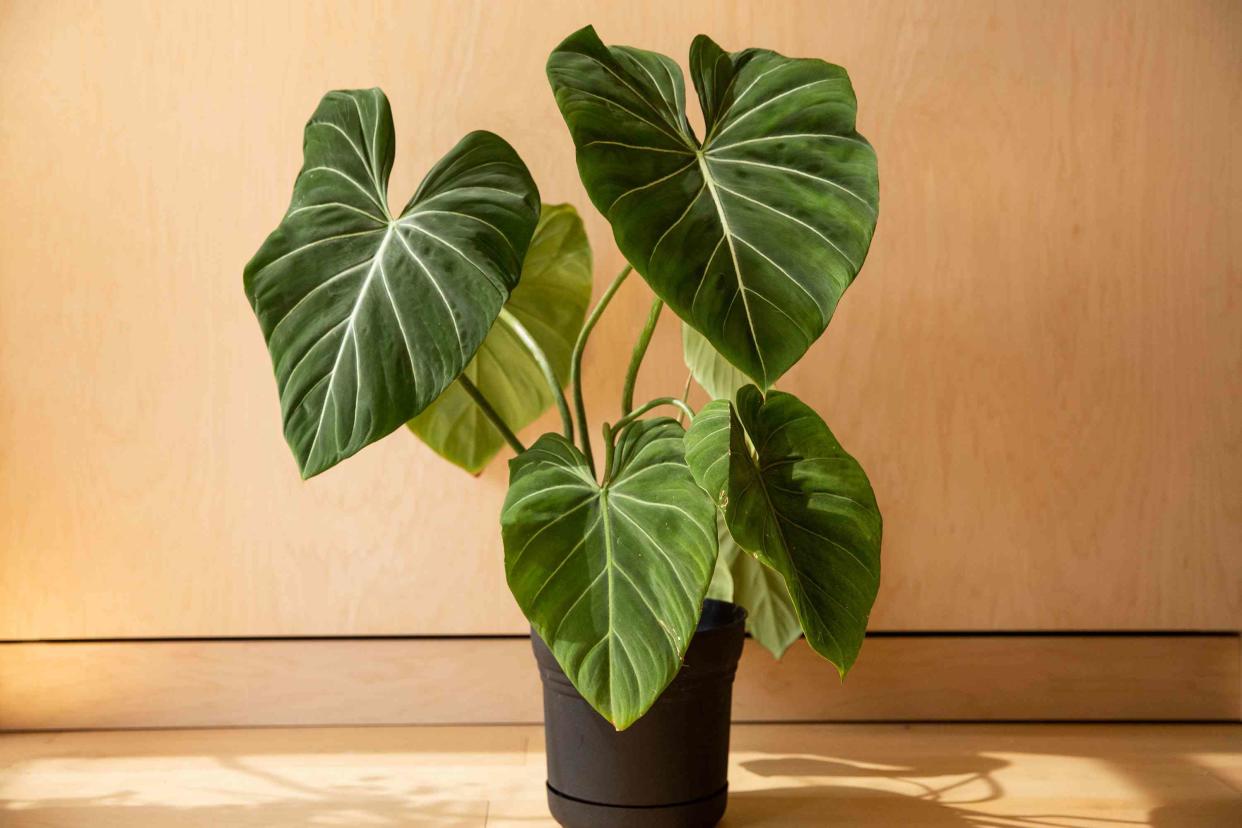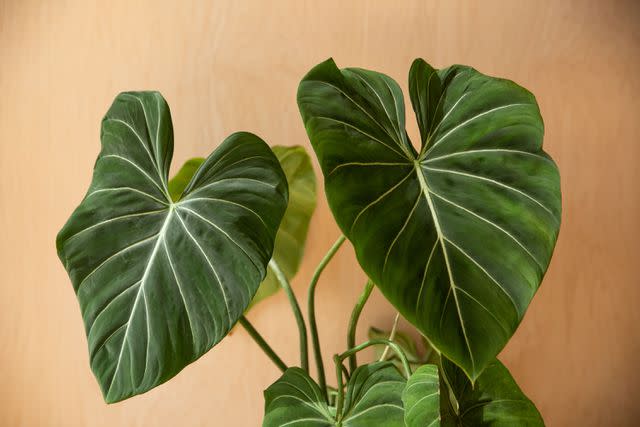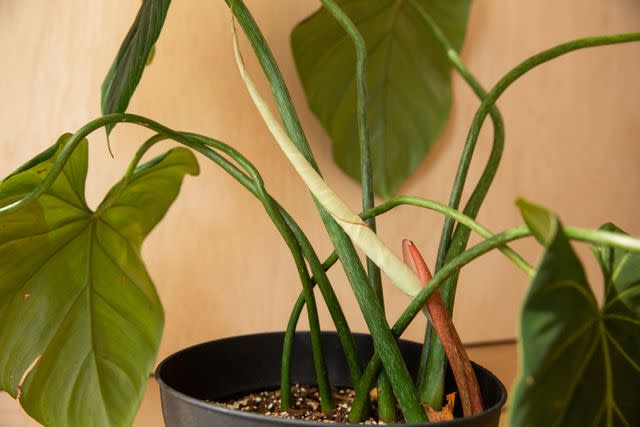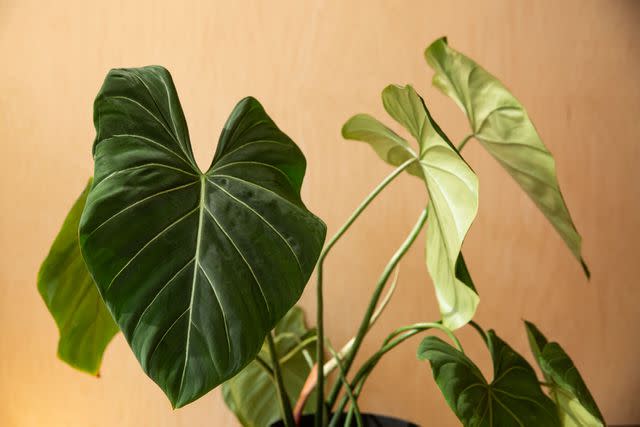How to Grow and Care for Philodendron Gloriosum

The Spruce / Phoebe Cheong
Reviewed by Barbara Gillette
It's little wonder that hundreds of philodendron species are popular houseplants. Prized for their heart-shaped foliage, these tropical plants are typically easy-to-care-for and adding a few will help transform your space into an indoor jungle. Part of the appeal of this plant is its forgiving, low-maintenance nature. It's the perfect tropical houseplant for even the most brown-thumbed plant lover. This plant is sensitive to overwatering and likes bright, indirect light. Just keep it out of reach of inquisitive four-legged friends. The Philodendron gloriosum is toxic to people and pets. Read on for our care guide.
Botanical Name | Philodendron gloriosum |
Common Name | Creeping velvet philodendron |
Family | Araceae |
Plant Type | Perennial |
Mature Size | Up to 2.5 feet tall |
Sun Exposure | Partial |
Soil Type | Well-drained |
Soil pH | Acidic, Neutral |
Bloom Time | Rarely blooms indoors |
Flower Color | N/a |
Hardiness Zones | 10-11 (USDA) |
Native Area | South America |
Toxicity | Toxic to people, toxic to pets |
Philodendron Gloriosum Care
Here are the main care requirements for growing Philodendron gloriosum:
Sensitive to overwatering
Likes bright, indirect light
Loves warmth and humidity

The Spruce / Phoebe Cheong

The Spruce / Phoebe Cheong

The Spruce / Phoebe Cheong
Light
To maximize the health and size of the gloriosum's foliage, you should offer it plenty of bright, indirect light. A west- or east-facing window with morning sun and filtered afternoon light usually work well. Too much direct sun can scorch the leaves and result in droopy growth, but dim conditions mean this slow-growing plant won't develop well and can become overly leggy.
Soil
Potting mixes for aroid species are widely available. If you can't find one or you want to make your own, make sure it is loose and well-draining to help prevent root rot. One part standard potting mix, one part orchid bark, and one part perlite works well.
Water
Your Philodendron gloriosum is sensitive to overwatering. Root rot is common if this plant has wet feet or the pot has poor drainage. It's best to wait for the top 2 to 3 inches of potting mix to dry out before watering, and don't panic if you forget to water occasionally.
Temperature and Humidity
They do well in most home spaces, but it's not uncommon to find these tropical plants in bathrooms—they love warmth and humidity. If you regularly have temperatures dipping below 55 degrees Fahrenheit, you'd be better off selecting plants that can handle colder conditions.
They also appreciate high humidity (over 50 percent). If you have dry air blasting from your air conditioning, consider using a humidifier and putting your gloriosum on a pebbled-filled tray with water.
Fertilizer
Using a half-strength liquid fertilizer every month or two during the growing season can encourage more vigorous and healthy foliage on this slow-growing plant. But they aren't heavy feeders, and too much fertilization can cause root burn and yellowing leaves.
The 15 Best Places to Buy Plants Online in 2024
Pruning
There aren't any high-maintenance requirements for pruning your Philodendron gloriosum. It's just a case of removing unhealthy, straggly, or dead foliage. That way, all the energy goes into the growth of the new, healthier foliage.
Propagating Philodendron Gloriosum
Unlike the vining philodendron species, propagation is best done via vegetative rhizomes cuttings (the underground stem from this creeping variety). Follow these steps for a chance of success:
Using a pair of sharp scissors or pruning shears, find a suitable section of rhizome (often seen growing near the surface of the soil) and cut pieces with at least a couple of leaves growing on it.
Let the end of the cutting callous over for a few hours before potting up the individual section/s in a moist (but not saturated) sphagnum moss.
Ideally, cover the pot with a plastic bag to retain moisture and humidity.
Wait for around 2 to 4 weeks for roots to establish on the cuttings. During this time, let some air into the plastic bag every couple of days for a few minutes to keep the micro climate from turning stale.
Move the cutting to a loose, well-drained potting mix.
Potting and Repotting Philodendron Gloriosum
With its spreading, crawling growth habit, a pot that is more wide than deep is appreciated by the Philodendron gloriosum—a long, narrow, and rectangular shape works well. It also needs to be one with good drainage holes—you want to avoid wet feet. However, with its slow-growing habit, you probably won't need to repot the plant more than every two or three years.
Look out for the plant starting to lean out over the edge of the pot, growth slowing, and new leaves reducing in size. These are typical signs it is becoming rootbound and ready for repotting.
Overwintering
The Philodendron gloriosum loves warmth and humidity and will be harmed in the cold. If grown outdoors, make sure to bring inside in the fall and place near a bright window
Common Pests & Plant Diseases
This is a pretty low-maintenance plant, but the Philodendron gloriosum can be affected by aphids, spider mites, and fungus. To combat the pests, use neem oil or insecticide. As for fungus/root rot, you'll want to avoid overwatering. Make sure the soil is starting to dry out before watering again.
Common Problems With Philodendron Gloriosum
While this plant is known for being low-maintenance and trouble-free, it still needs the right conditions to thrive. The issues below are common signs you aren't giving your Philodendron gloriosum quite what it needs.
Leaves Turning Yellow
If your plant has yellowing leaves it isn't necessarily something to worry about. Old foliage at the base of the plant can start to yellow and drop as part of the natural cycle. If it's happening with newer foliage, this can be a sign of over or underwatering or overfeeding your plant.
Drooping Leaves
The most common reason you might start to see those gorgeous leaves droop is not getting the moisture levels right. Wet feet and subsequent root rot are the most serious issue, but letting the plant dry out too much is another reason.
Browning Tips
If your Philodendron gloriosum isn't getting enough moisture (through watering or humidity) or it is being subject to too much direct sun, then leaf scorch, starting on the tips, is common. Consider the location of your plant carefully, and consider using a humidifier if your home is dry.
Frequently Asked Questions
How fast does Philodendron gloriosum grow?
When compared with some philodendron species, you need patience when it comes to this plant. It's pretty slow-growing, and new foliage usually takes over a month to open up.
Why is Philodendron gloriosum so expensive?
Many philodendron species are in high demand, but those readily available aren't going to break the bank. The gloriosum is a very on-trend variety because of its unique appearance. The price is higher than a standard philodendron because supply can't always meet demand.
Philodendron gloriosum vs glorious?
The Philodendron ‘glorious’ is a hybrid of the Philodendron gloriosum and Philodendron melanochrysum. It is a climbing variety rather than having a crawling habit like the gloriosum.
Read the original article on The Spruce.
